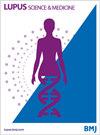系统性红斑狼疮在临床实践中的负担:系统性红斑狼疮前瞻性观察队列研究(SPOCS)通过干扰素基因特征得出的基线数据
IF 3.7
2区 医学
Q1 RHEUMATOLOGY
引用次数: 0
摘要
目的 系统性红斑狼疮前瞻性观察队列纵向研究(SPOCS)旨在评估系统性红斑狼疮的总体病程和 I 型干扰素 4 基因特征(IFNGS)。在此,我们按 IFNGS 和基线疾病活动度描述 SPOCS 患者的特征。方法 SPOCS([NCT03189875][1])是一项根据系统性红斑狼疮国际合作诊所(SLICC)/美国风湿病学会(ACR)标准对系统性红斑狼疮患者进行的国际研究。自2017年6月至2022年11月,对来自8个国家135个中心的入组患者进行了为期≤3年的半年随访。根据系统性红斑狼疮疾病活动指数-2000评分(SLEDAI-2K<10/≥10)和IFNGS状态(高/低)对基线人口统计学、疾病特征、器官系统受累/损伤和复发进行了描述性分析。结果 研究对象(n=823)中 93.2% 为女性,平均(标清)年龄为 45.3(13.9)岁,确诊时间为 11.1(9.2)年;52.4% 的基线 SLICC/ACR 损伤指数评分≥1。3%)vs <10分的患者更年轻(平均42.8 (13.7) vs 46.6 (14.2)岁;标称P=0.001),系统性红斑狼疮病程更短(10.4 (8.6) vs 12.4 (9.6)岁;标称P=0.012),病情发作更严重(12.9% vs 5.3%;标称P=0.001)。IFNGS高的患者(739人中有522人,占70.6%)在首次出现系统性红斑狼疮表现时比IFNGS低的患者年轻(30.0 (12.7) vs 36.8 (14.6)岁;标称P<0.001)。IFNGS高的患者比例因种族而异(标称P<0.001),亚洲人(83.3%)和黑人(86.5%)的比例高于白人(63.5%)。IFNGS 高分患者与 IFNGS 低分患者相比,血液(12.6% vs 4.1%)、免疫(74.4% vs 45.6%)或皮肤(69.7% vs 62.2%)受累的比例更高。结论 我们发现了疾病活动度高和/或 I 型 IFN 信号升高的患者的主要特征,这些患者都是系统性红斑狼疮患者,他们的需求尚未得到满足。基线SLEDAI-2K≥10与疾病持续时间较短和复发较严重有关。与 IFNGS 低的患者相比,IFNGS 高的患者确诊时更年轻,器官受累的模式也更独特。如有合理要求,可提供相关数据。根据阿斯利康公司在 [https://astrazenecagrouptrials.pharmacm.com/ST/Submission/Disclosure][2] 中描述的数据共享政策,可获取本手稿中描述的研究结果所依据的数据。[1]:/lookup/external-ref?link_type=CLINTRIALGOV&access_num=NCT03189875&atom=%2Flupusscimed%2F10%2F2%2Fe001032.atom [2]: https://www.astrazenecaclinicaltrials.com/our-transparency-commitments/本文章由计算机程序翻译,如有差异,请以英文原文为准。
Burden of systemic lupus erythematosus in clinical practice: baseline data from the SLE Prospective Observational Cohort Study (SPOCS) by interferon gene signature
Objective The longitudinal Systemic Lupus Erythematosus Prospective Observational Cohort Study (SPOCS) aims to assess SLE disease course overall and according to type I interferon 4 gene signature (IFNGS). Here, we describe SPOCS patient characteristics by IFNGS and baseline disease activity. Methods SPOCS ([NCT03189875][1]) is an international study of patients with SLE according to Systemic Lupus International Collaborating Clinics (SLICC)/American College of Rheumatology (ACR) criteria. Enrolled patients from 135 centres in 8 countries were followed biannually for ≤3 years from June 2017 to November 2022. Baseline demographics, disease characteristics, organ system involvement/damage and flares were analysed descriptively according to SLE Disease Activity Index-2000 score (SLEDAI-2K <10/≥10) and IFNGS status (high/low). Results The study population (n=823) was 93.2% female, with mean (SD) age 45.3 (13.9) years and 11.1 (9.2) years since diagnosis; 52.4% had baseline SLICC/ACR Damage Index score ≥1. Patients with SLEDAI-2K scores ≥10 (241 of 584, 41.3%) vs <10 were younger (mean 42.8 (13.7) vs 46.6 (14.2) years; nominal p=0.001), had shorter SLE duration (10.4 (8.6) vs 12.4 (9.6) years; nominal p=0.012) and more severe flares (12.9% vs 5.3%; nominal p=0.001). IFNGS-high patients (522 of 739, 70.6%) were younger than IFNGS-low patients at first SLE manifestation (30.0 (12.7) vs 36.8 (14.6) years; nominal p<0.001). Proportions of IFNGS-high patients differed according to race (nominal p<0.001), with higher proportions among Asian (83.3%) and black (86.5%) versus white patients (63.5%). Greater proportions of IFNGS-high versus IFNGS-low patients had haematological (12.6% vs 4.1%), immunological (74.4% vs 45.6%) or dermal (69.7% vs 62.2%) involvement. Conclusions We identified key characteristics of patients with high disease activity and/or elevated type I IFN signalling, populations with SLE with high unmet needs. Baseline SLEDAI-2K ≥10 was associated with shorter disease duration and more severe flares. IFNGS-high patients were younger at diagnosis and had distinct patterns of organ involvement, compared with IFNGS-low patients. Data are available upon reasonable request. Data underlying the findings described in this manuscript may be obtained in accordance with AstraZeneca’s data sharing policy described at [https://astrazenecagrouptrials.pharmacm.com/ST/Submission/Disclosure][2]. [1]: /lookup/external-ref?link_type=CLINTRIALGOV&access_num=NCT03189875&atom=%2Flupusscimed%2F10%2F2%2Fe001032.atom [2]: https://www.astrazenecaclinicaltrials.com/our-transparency-commitments/
求助全文
通过发布文献求助,成功后即可免费获取论文全文。
去求助
来源期刊

Lupus Science & Medicine
RHEUMATOLOGY-
CiteScore
5.30
自引率
7.70%
发文量
88
审稿时长
15 weeks
期刊介绍:
Lupus Science & Medicine is a global, peer reviewed, open access online journal that provides a central point for publication of basic, clinical, translational, and epidemiological studies of all aspects of lupus and related diseases. It is the first lupus-specific open access journal in the world and was developed in response to the need for a barrier-free forum for publication of groundbreaking studies in lupus. The journal publishes research on lupus from fields including, but not limited to: rheumatology, dermatology, nephrology, immunology, pediatrics, cardiology, hepatology, pulmonology, obstetrics and gynecology, and psychiatry.
 求助内容:
求助内容: 应助结果提醒方式:
应助结果提醒方式:


